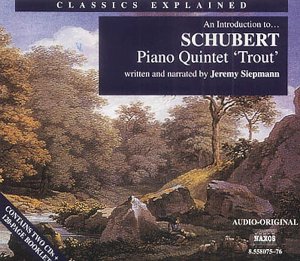This is the latest in Naxos’s and Jeremy Siepmann’s
‘Classics explained’ series following on from Dvořák’s
9th (Naxos 8.558065-66) and Beethoven’s 6th
(Naxos 8.558034-35 review).
In the series a work is discussed and analysed in detail rather
in the style of BBC Radio 3’s Sunday programme ‘Understanding
Music’.
When I first unwrapped this handsomely packaged
album I suspected, not having seen or heard the other two, that
the analysis would be on one disc and the complete work on the
second. This is sadly not so. The plan is this; each movement
is discussed in some detail. A brief section is analysed and then
heard, after practically each musical example a new track begins
meaning that some tracks are very short and that CD1 has 58 tracks
(movements 1 and 2) and CD2 has 68 (movements 3, 4 and 5). The
complete text is given in the 120 page accompanying booklet all
written by Siepmann. This booklet is a luxury item in itself and
a very significant part of the product. The first section, divided
into three essays, is ‘The composer and his work’. It outlines
life in Schubert’s Vienna, followed by a biographical sketch with
comments on his most important pieces, and then an attempt to
place the quintet in context. Then comes the analysis. The complete
spoken text is given, as mentioned, followed by a useful ‘Structural
Overview’ and then, in my view, a slightly pretentious essay on
the ‘Role of the Interpreter’.
The next essay ‘The Art of the Listener’ is divided
into five sections including ‘What music is’ and ‘The Basic Forms
of Music’. And if that’s not enough there is a very useful Glossary
of fourteen pages explaining key words such as modulation and
octave.
A word of warning: CD1 spends about 45 minutes
analyzing the first movement which is the longest and most complex.
The last movement analysis goes off at a tangent discussing how
a composer may develop his material. The other movements are dismissed
relatively quickly and efficiently.
The performance is completely standard and safe,
nicely recorded and balanced and wonderfully uncontroversial.
I found myself wondering however at the market
for these ‘Classics Explained’ CDs. Certainly as a teacher if
this was a set work I would find it an invaluable aid as would
my pupils, although in the UK it is probably too detailed for
GCSE but just right for AS and A2 level. University students,
if they didn’t find the tone sometimes too patronizing, might
also consider it handy although standard repertoire is rarely
on the University or Music College’s ‘works to be studied list’
beyond the 1st year. As for music-loving adults, then
I am reminded that Debussy commented that music should not be
analysed as the life blood could so easily be removed and the
love for it lost for ever. I suspect that the analyses would be
skipped by many as they can seem too detailed especially in the
case of Movement 1.
Jeremy Siepmann though is potentially onto a
winner. At about £10 this is a fine item and one to constantly
refer back to. He has now left the BBC (since 1992) to form his
own independent production company dealing with music programmers
and in producing discs like this. The presentation and concept
is excellent. It is just a case of do you like the execution?
Gary Higginson
see also review
by Robert Hugill
Others in the series reviewed by musicweb:
Instruments
of the orchestra
Bach
Life and works
Bach
Brandenburgs 4 and 5
Beethoven
Life and works
Brahms
Life and works
Brahms
Piano Concerto no 2
Liszt
Life and works
Mozart
Life and works
RAVEL:
Bolero & Ma Mère L'Oye
Tchaikovsky
Life and works
Verdi
Life and works
Verdi
Aida
An
introduction to the series
